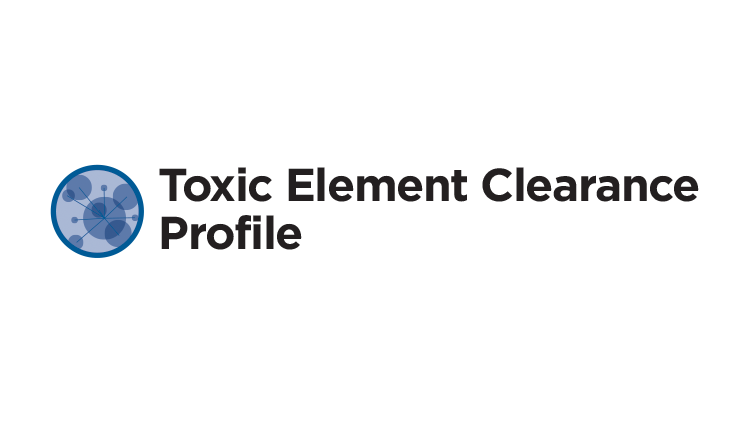Description
Identify Exposure to Toxic Heavy Metals
The Toxic Element Clearance Profile (TECP) is a toxic exposure profile that measures urinary excretion of 20 potentially harmful toxic metals. In addition to measuring classic elemental toxins such as mercury and lead, this profile includes elements used in medical, aerospace, nuclear, and high-tech electronic industries. Identifying exposure to these metals, then minimizing continued exposure is crucial for clinical improvement.
When should testing for toxic elements be considered?
Occupational and industrial exposure, or exposure through various hobbies may put patients at higher risk for toxicity. Those most at risk include workers in industries such as metal refining, alloying, parts manufacturing in aerospace and machine tools, electronics and computer manufacturing, welding, plumbing, construction, oil refining, mining, waste disposal, pesticide manufacturing and application, pigment and coating manufacturing, petrochemical production, dentistry, firearms and ammunition, and work with glass, dyes, ceramics, or paints.1-3
In addition to occupational exposures, everyday activities may put patients at risk of increased exposure to toxic metals: proximity to the above-mentioned industries where groundwater and air contamination can distribute metals; smoking; living in homes with older wells, pipes, and building materials; consumption of foods known to be contaminated with metals (seafood, rice); taking supplements from manufacturers lacking good manufacturing practice (GMP); use of personal care products and cosmetics; taking certain medications; exposure to emissions and exhaust fumes; and exposure to paints, dental amalgams, and fireworks.
Symptoms and conditions associated with heavy metal toxicity
A wide range of acute and chronic conditions have been associated with toxic heavy metals including, but not limited to:
- Neurological disorders (neuropathy, headaches)2,4-6
- Cognitive decline2,4
- Mood disorders (depression)4
- Cardiac abnormalities (arrhythmias, abnormal ECG)7-9
- Diabetes5,10
- Cancer3,5,11
- Reproductive issues5,8,9
- GI concerns (vomiting, diarrhea)4,6,8,9
- Lung issues4,8,9
- Renal impairment4,6,8
- Skin rashes4,9
- Anemia and other hematologic disorders8,12
The Toxic Element Clearance Profile Analytes
- Lead
- Mercury
- Aluminum
- Antimony
- Arsenic
- Barium
- Bismuth
- Cadmium
- Cesium
- Gadolinium
- Gallium
- Nickel
- Niobium
- Platinum
- Rubidium
- Thallium
- Thorium
- Tin
- Tungsten
- Uranium
The TECP can be ordered as a random (spot), timed, or a 24-hour urine collection. In random or timed collections, the toxin levels are ratioed to creatinine only; in a 24-hour collection the levels are ratioed to volume or to creatinine. By utilizing creatinine concentration as the given ratio standard, the variations in time frames provide useful comparisons upon subsequent testing. For practitioners desiring a sample that is ratioed to volume, the collection must always be a 24-hour collection. These various options are offered to accommodate different protocols. The literature often describes 24-hour collections as being the most comprehensive, and to account for variations that may happen throughout the day. However, random samplings and/or timed collections also provide useful information to screen for exposures.13 Clinicians often use timed samples as part of provoked chelation protocols. Please note, Genova does not provide chelation or provocation protocols and reference ranges apply to non-provoked/non-chelated conditions.
What advantage does the Toxic Element Clearance Profile offer compared to other diagnostics?
Metals can be measured in various sample types including blood, urine, hair, and nails as the most accessible tissues to quantify exposure. However, there are multiple variables that impact which sample type is most appropriate including the metal’s half-life, valence state/form/species, toxicokinetics, dose, time span of exposure, and route of exposure.3,14,15
Genova offers testing for minerals and metals in either blood or urine with the TECP being one of the most comprehensive urine metal profiles available. Both sample types indicate recent exposure with a few exceptions. In general, the window of exposure for urine is approximately a few hours to a few days, whereas blood is often a longer window, from a few hours to up to a few months. The actual time frame that each sample type represents varies for each metal being measured due to the variables listed above.1,3,14 For example, urinary cadmium is thought to reflect kidney cadmium concentrations with a half-life of 15-30 years. Urine is thought to reflect cumulative body burden of cadmium.16 Urinary levels do not rise significantly after acute exposure. Elevated blood cadmium levels confirm recent acute exposure.17-19 More information on the nuances of metals and sample types can be found in the Toxic Element Chart.
Once a metal enters the body, it is either eliminated or deposited into tissue, which can result in long-term storage. Metals are eliminated through feces, bile, urine, sweat, hair, and nails. Assessment of tissue accumulation, also referred to as “body burden”, is challenging. Some clinicians perform a provoked urine test by using a chelator to liberate stored metals from the tissues.14 Many clinicians opt to perform two tests — a pre- and post-provoked sample — to distinguish between recent exposure versus tissue storage. Please note, Genova does not provide chelation or provocation protocols and reference ranges apply to non-provoked/non-chelated conditions.
Hair analysis is not offered at Genova, as external contamination may interfere with results. In general, hair is not a reliable sample type to determine exposure to most metals.3
Genova’s Methodology
Metals are measured using Inductively Coupled Plasma Mass Spectrometry (ICP-MS) and creatinine via alkaline picrate. Genova measures total levels and does not speciate individual metals. Reference ranges were developed from a healthy population under non-provoked/non-chelated conditions. Reference ranges do not provide absolute levels at which a related symptom may occur — clinical correlation is recommended. Provocation with challenge substances/chelators may raise the urine level of some elements and is thought to represent “body burden.”14 Reference ranges have not been established for provoked urine samples. All toxic metals are reported as micrograms/g creatinine or as micrograms per 24 hours (if a 24-hour urine specimen is provided).
What can clinicians and patients expect from toxic element testing?
The Toxic Element Clearance Profile assesses urinary excretion of toxic elements acquired through either chronic or acute exposure. Minimizing or eliminating continued exposure to the toxic element is crucial. Clinicians may choose to initiate detoxification and/or nutritionally supportive treatments based on results if medically appropriate.



